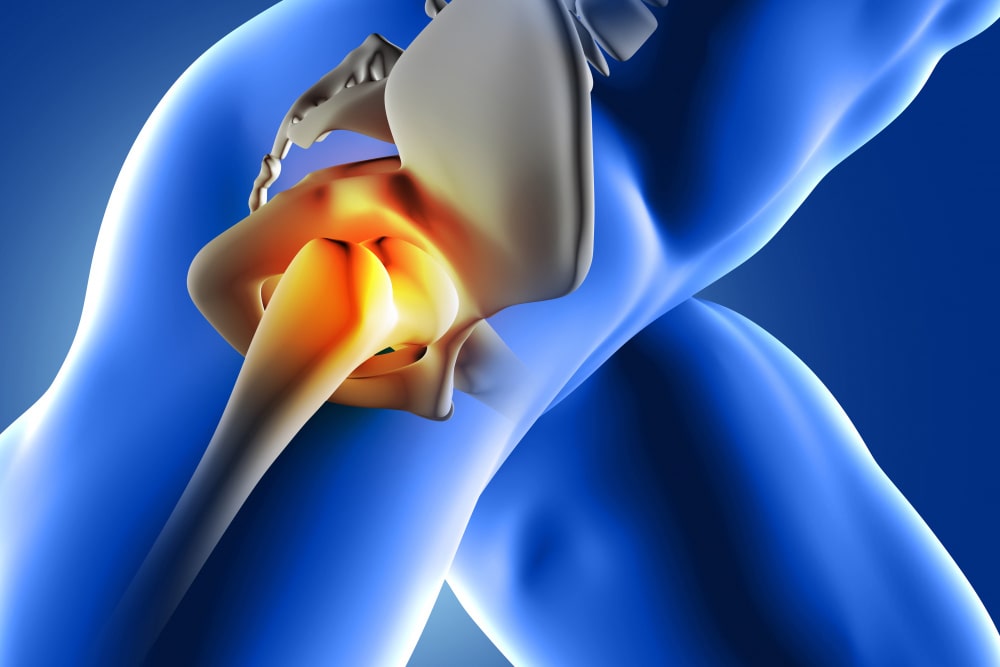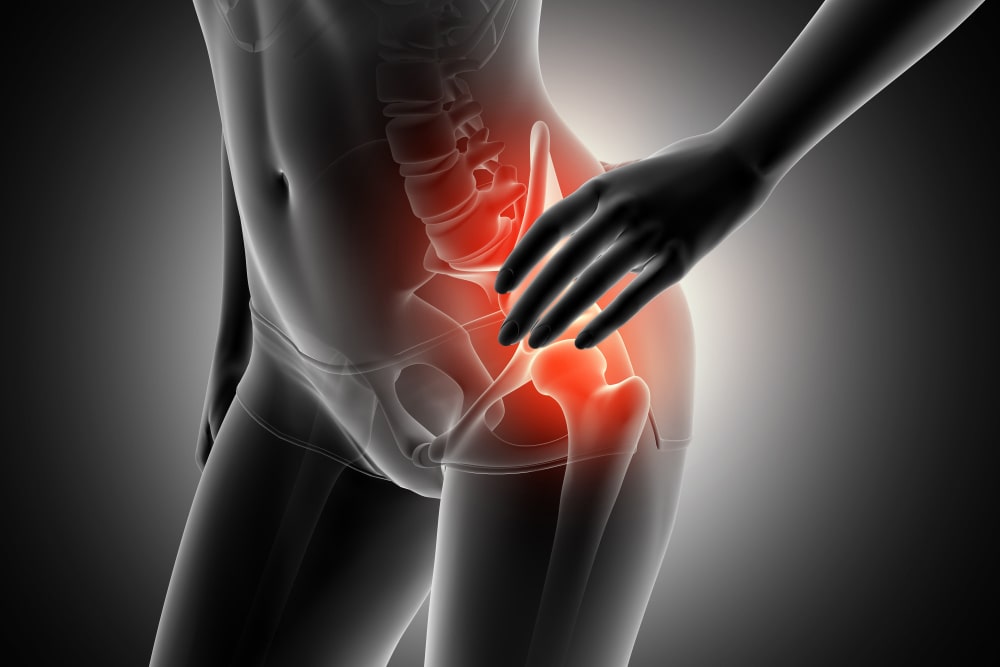Lateral hip pain is a common complaint in individuals of all ages. It can range from mild and manageable to severe and debilitating. With the right diagnosis, treatment plan, and lifestyle modifications, lateral hip pain can be managed effectively. This article will provide an overview of the anatomy of the hip joint, causes of lateral hip pain, how it is diagnosed and treated, as well as ways to prevent it.
Anatomy of the Hip
The hip joint is a large, mobile ball-and-socket type joint, which consists of two bones – the femur and the pelvis. The head of the femur fits snugly into a socket in the pelvis called the acetabulum. The ligaments that surround the joint provide stability, while the muscles in the area help to move it.
What is Lateral Hip Pain?
Lateral hip pain is pain felt on the outside of your hip joint or radiating down your outer thigh. It can be caused by a variety of conditions ranging from muscle strain and tendonitis to bursitis and IT band syndrome.
Read More: Laser Therapy for Pain: A Beacon of Hope in Alleviating Discomfort
Common Causes of Lateral Hip Pain
1. Muscle Strains
A muscle strain occurs when a muscle or tendon is overstretched or torn, usually due to repetitive movements or excessive load on the joint. This can cause pain, swelling and bruising in the area. It is most commonly seen in athletes who engage in high-impact sports such as running or basketball.
2. Bursitis
Bursitis is a condition caused by inflammation of the bursa, which is a fluid-filled sac that cushions the bones, tendons and muscles around a joint. It can be caused by repetitive motions, as well as direct trauma or infection. Symptoms include pain, tenderness and swelling in the area.
3. Iliotibial (IT) Band Syndrome
IT band syndrome is an overuse injury that occurs when the iliotibial (IT) band becomes tight or inflamed due to repetitive motions such as running or cycling. The pain is usually felt along the outside of the hip and can range from mild to severe.
4. Hip Labral Tear
Hip labral tears are tears of the labrum, which is a ring of cartilage that provides stability around the hip joint. This can occur from an acute injury or due to degenerative changes in the joint itself. Symptoms include pain, clicking and catching in the area as well as loss of range of motion.
5. Referred Pain from the Lower Back:
In some cases of lateral hip pain, the source of the pain may actually be located in the lower back. This is known as referred pain and can occur due to conditions such as a herniated disc or sciatica. Symptoms include pain that radiates down the leg and into the outer thigh area.

Read More: Chest Pain While Pregnant: What Causes It, How to Relief Pain?
Symptoms of Lateral Hip Pain
The most common symptom of lateral hip pain is a sharp, shooting pain that radiates down the outside of your thigh and into your knee. It can also be accompanied by swelling, tenderness and a feeling of instability or weakness in the joint.
Diagnosis of Literal Hip Pain
If you suspect you have lateral hip pain, it’s important to get a proper diagnosis from your doctor. Your doctor will likely perform a physical exam and ask questions about your medical history and lifestyle in order to determine the cause of your pain. Imaging tests such as X-rays or MRIs may be ordered to help diagnose the condition and rule out other potential causes.
Read More: Pain Inside Thigh: Causes, Treatment, and Prevention
Treatment Options for Lateral Hip Pain Relief
The treatment plan for lateral hip pain will depend on the underlying cause and severity of the condition. Treatments can range from simple lifestyle modifications to medications, injections or even surgery.
1) Rest and Activity Modification
Resting your hip and avoiding activities that worsen your symptoms is an important part of treating lateral hip pain. Your doctor may also suggest modifying your activities and using assistive devices such as a cane or a walker to reduce the strain on your affected hip.
2) Physical Therapy
Physical therapy is often recommended to help strengthen and stretch the muscles in the area, improve mobility and flexibility, and reduce pain and inflammation. A physical therapist may suggest exercises such as hip flexor stretching, glute strengthening, and core stabilization to help alleviate lateral hip ache.
3) Medications
Your doctor may recommend over-the-counter medications such as ibuprofen or naproxen to reduce inflammation and pain associated with the condition. In more severe cases, prescription medications such as corticosteroid injections or even opioids may be used.
4) Injections
In some cases, your doctor may recommend a local steroid injection into the affected area to reduce inflammation and pain. This is usually done in conjunction with physical therapy and activity modification for maximum benefit.
5) Surgical Intervention
In rare cases, surgery may be recommended to repair any damage or remove the underlying cause of lateral hip pain. Surgery is usually only considered when all other treatments have failed and the pain is severe and debilitating.
Read More: Belly Button Pain During Pregnancy: Causes and Remedies
Preventing Lateral Hip Pain
The best way to prevent lateral hip pain is to maintain a healthy lifestyle with regular physical activity and stretching. Strengthening the muscles in the area and keeping them flexible can help reduce your risk of developing lateral hip ache. Additionally, make sure to wear proper footwear when exercising and avoid high-impact activities if you have a pre-existing condition or an injury that puts you at risk for lateral hip ache.
Lifestyle Modifications
There are a few lifestyle modifications you can make to help manage and prevent lateral hip pain:
- Increase your activity level gradually, especially if you are new to exercise.
- Avoid activities that put excessive strain on your hip such as running or high impact sports.
- Stretch regularly to keep the muscles in the area flexible and strong.
- Wear proper footwear that supports your feet and provides cushioning.
- Maintain a healthy weight to reduce the strain on your hips.
- Take breaks between activities if necessary, and avoid overexerting yourself.
With the right management techniques and lifestyle modifications, lateral hip pain can be managed effectively. If you are experiencing any kind of hip pain, it’s important to consult with your doctor for an accurate diagnosis and treatment plan.
If you have lateral hip ache, it’s best to stay active by doing low-impact activities such as swimming or biking. These can help keep your joint mobile without putting too much strain on it. If done regularly, these activities can also help strengthen the muscles in the area and improve joint flexibility. Additionally, be sure to stretch the muscles around your hip before and after any physical activity in order to keep them loose and prevent further injury.
Read More: Pain After Ejaculation: Causes, Symptoms, and Treatment
Exercises for Lateral Hip Health
If you suffer from lateral hip pain, there are certain exercises and stretches that can help reduce your symptoms:
- Bridging – Lie on your back with your knees bent and lift your hips off the floor. Hold for a few seconds then relax. Repeat 10 times.
- Quadriceps Stretch– Standing up straight, hold onto something for balance, slowly grab your foot and pull it up towards your backside. Hold for 30 seconds then switch legs.
- Hamstring Stretch– Sitting on the floor with your legs straight out in front of you and your feet flexed, lean forward from the hips and reach towards your toes. Hold for 30 seconds then switch sides.
- Glute Stretch– Lying on your back, bend one knee and bring it across the body until you feel a stretch in the glutes. Hold for 20 seconds then switch sides.
By stretching regularly and doing these exercises as part of your routine, you can help prevent lateral hip pain and improve joint flexibility.
Read More: Sigmoid Colon Pain: What Causes It, How to Relief Pain?
When to Seek Medical Attention
If you are experiencing any kind of hip pain, it’s important to seek medical attention in order to get a proper diagnosis and treatment plan. Additionally, if your hip pain has not been improving with lifestyle modifications or home remedies such as rest and physical therapy, it’s best to consult with your doctor as soon as possible. Your doctor can help determine the cause of your pain and recommend an effective treatment plan to help relieve your symptoms.
Conclusion
In conclusion, lateral hip pain is a common condition that can be managed and prevented with the right lifestyle modifications. Resting, activity modification, physical therapy, medications and injections are all potential treatments for lateral hip pain. Additionally, it’s important to keep your muscles flexible and strong by stretching regularly and doing exercises specific to hip health. If lifestyle modifications do not help, it’s important to seek medical attention in order to get an accurate diagnosis and the most appropriate treatment plan. With the right management techniques, lateral hip ache can be treated effectively.
Read More: Stomach Bug While Pregnant: Causes, Symptoms, Remedies
FAQs
Yes, lateral hip pain is quite common among athletes and active individuals. It is important to take the necessary steps to prevent it from occurring in the first place by incorporating proper stretching and strengthening exercises into your routine.
Yes, there are a number of home remedies that may help to alleviate lateral hip pain. These include rest, activity modification, ice and heat therapy, massage, stretching and strengthening exercises. However, if these methods do not provide relief it is important to seek medical advice for an accurate diagnosis and treatment plan.
Yes, exercising regularly and incorporating stretching into your routine can help to prevent lateral hip pain. Additionally, make sure to wear proper footwear when exercising and avoid high-impact activities if you have a pre-existing condition or an injury that puts you at risk for lateral hip ache.
Yes, in some cases where other treatments have not been successful, surgery may be recommended for hip pain relief. This will depend on the severity and cause of your hip pain, so it is important to consult with a doctor for an accurate diagnosis and treatment plan.

